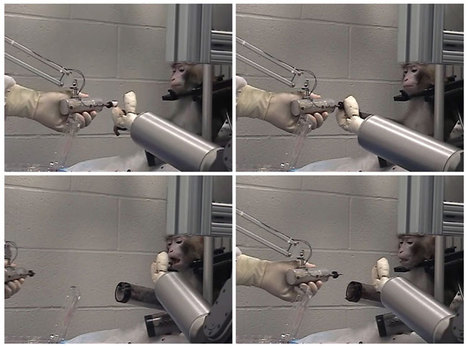 “A grid in the monkey’s brain carried signals from 100 neurons for the mechanical arm to grab and carry snacks to the mouth.” Source of caption and photos: online version of the NYT article quoted and cited below.
“A grid in the monkey’s brain carried signals from 100 neurons for the mechanical arm to grab and carry snacks to the mouth.” Source of caption and photos: online version of the NYT article quoted and cited below.
(p. A1) Two monkeys with tiny sensors in their brains have learned to control a mechanical arm with just their thoughts, using it to reach for and grab food and even to adjust for the size and stickiness of morsels when necessary, scientists reported on Wednesday.
The report, released online by the journal Nature, is the most striking demonstration to date of brain-machine interface technology. Scientists expect that technology will eventually allow people with spinal cord injuries and other paralyzing conditions to gain more control over their lives.
The findings suggest that brain-controlled prosthetics, while not practical, are at least technically within reach.
In previous studies, researchers showed that humans who had been paralyzed for years could learn to control a cursor on a computer screen with their brain waves and that nonhuman primates could use their thoughts to move a mechanical arm, a robotic hand or a robot on a treadmill.
The new experiment goes a step further. In it, the monkeys’ brains seem to have adopted the mechanical appendage as their own, refining its movement as it interacted with real objects in real time. The monkeys had their own arms gently restrained while they learned to use the added one.
For the full story, see:
BENEDICT CAREY. “Monkeys Think, Moving Artificial Arm as Own.” The New York Times (Thurs., May 29, 2008): A1 & A18.

